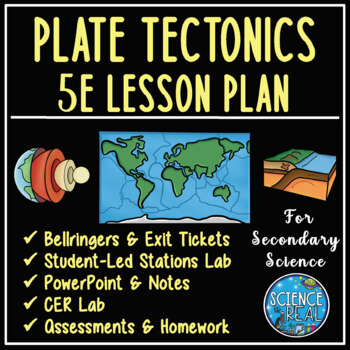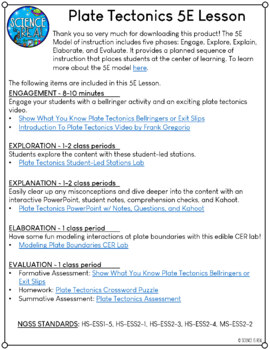Plate Tectonics 5E Unit Plan - Secondary Science
- Zip
Products in this Bundle (6)
showing 1-5 of 6 products
Bonus
Description
⭐ ⭐ ⭐ ⭐ Save over 30% off! After completing this 5E Plate Tectonics unit, students will be able to describe and demonstrate how plate tectonics causes major geologic features such as volcanoes, mid-ocean ridges, trenches, and mountains, types of plate boundaries, and how convection currents move and shape the lithosphere. This lesson plan follows the 5E method: Engagement, Exploration, Explanation, Elaboration, and Evaluation, and facilitates student-led learning with minimal prep time. This unit plan provides you with all the tools you need to teach this topic.
⭐ Click on the preview to see the complete lesson plan!
⭐ This Plate Tectonics 5E Unit Plan Includes:
Engagement:
• Plate Tectonics Bellringers (and Exit Tickets)
• Engaging and Inspiring Video Introduction to Plate Tectonics
Exploration:
• Plate Tectonics Student-Led Stations Lab
Explanation:
• Plate Tectonics PowerPoint with Student Notes
• Comprehension Check Questions and Kahoot
Elaboration:
• Modeling Interactions at Plate Boundaries CER Lab
Evaluation:
• Plate Tectonics Crossword (Homework)
• Plate Tectonics Pre-Made Assessment and Question Bank (100% Editable)
⭐ Topics ⭐
· Plate Tectonics and Continental Drift Theory
· Plate Boundaries and Interactions
· Sea-floor Spreading
· Convection Currents
· Geologic Features Created by Plate Interactions (Volcanic arc, mid-ocean ridge, deep-ocean trench, mountains, etc.)
· Hot Spots
· Ring of Fire
· Continental and Oceanic Crust
Happy Sciencing!
❤️CLICK TO FOLLOW SCIENCE IS REAL!
Get News of Sales, Discounts, and New Products!
Science Is Real! Terms of Use (TOU):
- Purchase of the product is for single classroom use by the purchaser only. It is a violation for individuals, schools, and districts to redistribute, edit, sell, or post this item on the Internet or to other individuals. Disregarding the copyright is a violation of the Digital Millennium Copyright Act and subject to legal action. – Intended for single and personal use only.
-By purchasing this product you acknowledge that you have read and understood the Terms of Use.
❤️ CHECK OUT MORE GREAT THINGS FROM SCIENCE IS REAL! ❤️
⭐ Volcanoes Powerpoint With Student Notes, Key, and KAHOOT!
⭐ Volcanoes Webquest - Digital and Printable
⭐ Volcanoes Lab - Edible CER Lab Activity
⭐ Earthquakes PowerPoint with Fill-in Notes, Comprehension Checks, and Kahoot
⭐ Earthquakes and Volcanoes Assessment - Editable!
⭐ Earthquakes and Volcanoes PowerPoint, Student Notes, & KAHOOT - Digital & Print
⭐ Earthquakes and Volcanoes Webquest - Google Slides, MS Word, and PDF Versions
⭐ Ring of Fire Mapping Activity and Questions - Earthquakes and Volcanoes
⭐ Rock Cycle PowerPoint, Notes, and Kahoot! - Digital & Printable
⭐ Rock Cycle Webquest with Types of Rocks - Digital and Printable
⭐ Rock Cycle Board Game with Question Cards!
⭐ Minerals Webquest - Digital and Printable
⭐ Earth's Layers Graphic Organizer - Digital and Printable - Distance Learning
⭐ Earth's Layers Lab - Edible & Engaging CER Quick Lab! - Digital & Printable
⭐ Earth's Layers PowerPoint, Student Notes, and Kahoot - Digital & Printable
⭐ Earth's Spheres Boom Cards - Digital and Printable Task Cards
⭐ Earth From Space Documentary by NOVA Video Worksheet - With FREE Video Link!



